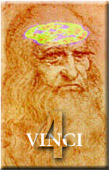About Vinci
Table of Contents

Email: vinci@nf.mpg.de
 | Max-Planck-Institut für neurologische Forschung mit Klaus-Joachim-Zülch-Laboratorien der Max-Planck-Gesellschaft und der Medizinischen Fakultät der Universität zu Köln Cologne, Germany http://www.nf.mpg.de |
Introduction
VINCI (“Volume Imaging in Neurological Research, Co-Registration and ROIs included”) was designed for the visualization and analysis of volume data generated by medical tomographical systems with special emphasis on the needs for brain imaging with Positron Emission Tomography (PET) [1], [2]. CPS Inc. (now Siemens Medical Solutions) has acquired a license to ship previous versions of VINCI with their PET systems, and it is the standard visualization tool for the HRRT brain scanner [3]. This site is dedicated to VINCI version 3.x, a new line of development: 2 Comparison to older versions.
VINCI is highly modular, extensible, compact and runs well on a wide range of systems; it can run directly off a CD-ROM or USB stick: no installation is required. We achieve this with a plugin architecture; VINCI can be remotely controlled through several high-level language interfaces, at the basis of which is our own XML-based scripting language.
Fully automatic registration for many routine uses is also possible, including online feedback of a running registration. The Co-Registration Plugin (MMM) is based on work by Číẑek et al. [4].
VINCI supports a number of file formats for reading (e.g. DICOM, NIfTI, ECAT7, MicroPET, Analyze, HRRT image, Bruker Paravision, Interfile) image files.
Please see Disclaimer and Licensing for legal issues.
Comparison to older versions
Development on previous versions of VINCI started in 1998 and as our institute was actively involved in the development of PET systems it was mandatory that we follow the manufacturer’s preference of platform: this explains a general shift from SunOS and then Solaris (the platforms favoured by previous generations of PET scanners) to MS Windows NT/2000/XP in the institute’s IT infrastructure at the time. Initial development was based on MS Windows’ native MFC with C++ for VINCI’s highly customized user frontend, as no platform-independent alternative seemed feasible then.
In 2005 we evaluated Trolltech’s Qt framework [5] (now acquired by Nokia Inc.) and decided to base a new line of development on this framework, which allows us to develop in parallel for the MS Windows, MacOS X, Linux and Solaris platforms.
We feel that this platform-indendent approach has significant advantages in terms of quality assurance as development tools on different platforms have complementary strengths. Furthermore, automated tests that work across a range of very different operating systems and hardware acquire a different level of quality [6]. This approach also reflects the current IT infrastructure at our institute which (again) has a strong and “traditional” emphasis on UNIX servers (Solaris and Linux), now coupled with desktop or laptop systems running MS Windows, MacOS X and Linux. We also use SunRay Thinclients served by a Sun T5120 system, a particularly efficient way to make VINCI available to many users.
VINCI 3 is not a direct port of the MFC-based version: our intention was to improve on known weaknesses and mend some bad design decisions. Naturally, we also want to take advantage of some powerful features of the Qt framework that were not available with MFC (and are still missing from many other frameworks).
Most of the transition has now been accomplished. However, some functionality in terms of IO plugins (reading MINC, HRRT Sinograms) still requires the previous version. The old web site can be found here: http://www.nf.mpg.de/vinci2.
VINCI 3 now has the ability to write VHIST [7], [8] files. Our recent work focuses on this new feature in the context of improved quality insurance and Good Scientific Practice [9], [10].
Hard- and Software Requirements
MS Windows
We develop on MS Windows XP and MS Windows 7, MS Windows Vista should also work. VINCI should run well even on moderately powerful hardware, in particular laptops. A standard installer is provided.
MacOS X
A significant amount of effort went into the Mac version of VINCI which should work fine on Intel Macs running Leopard (MacOS X 10.5) or newer. A standard installer is provided.
Linux
We develop on recent versions of Fedora Core and also test on Debian distributions. Let us know if you are interested.
Solaris 10
We used to develop VINCI on Sun SPARC systems running Solaris 10. However, development has ceased on this platform.
Disclaimer
THIS SOFTWARE IS PROVIDED AS-IS, WITHOUT ANY EXPRESSED OR IMPLIED WARRANTY. SPECIFICALLY, NEITHER THE MAX-PLANCK-INSTITUT FÜR NEUROLOGISCHE FORSCHUNG MIT KLAUS-JOACHIM-ZÜLCH-LABORATORIEN DER MAX-PLANCK-GESELLSCHAFT UND DER MEDIZINISCHEN FAKULTÄT ZU KÖLN NOR THE AUTHORS NOR THE CONTRIBUTORS WARRANT THAT THE FUNCTIONS CONTAINED IN THE SOFTWARE WILL MEET YOUR REQUIREMENTS, OR THAT THE OPERATION OF THE SOFTWARE WILL BE UNINTERRUPTED OR ERROR-FREE, OR THAT DEFECTS IN THE SOFTWARE WILL BE CORRECTED. TO THE EXTENT PERMITTED BY LAW, NEITHER THE MPI FÜR NEUROLOGISCHE FORSCHUNG NOR THE AUTHORS NOR THE CONTRIBUTORS SHALL BE LIABLE FOR ANY DAMAGES ARISING OUT OF OR RELATING TO THE USE OF THE SOFTWARE, INCLUDING BUT NOT LIMITED TO INCIDENTAL, SPECIAL, INDIRECT OR CONSEQUENTIAL DAMAGES OR ANY LOST PROFITS, BUSINESS INTERRUPTION, LOSS OF PROGRAMS OR OTHER DATA ON YOUR INFORMATION HANDLING SYSTEM.
Licensing
VINCI, in contrast to the VHIST [7] project, is currently not free software. We provide licenses for certain types of research collaborations, please register here http://www.nf.mpg.de/vinci3/registration.html if you are interested in a license.
Running VINCI without a license file defaults to the “lite” version which has the following limitations:
- saving of project files is disabled
- saving and exporting of image buffers is disabled
- the number of OrthoDisplays per OrthoView is limited to 5 (the full version can run with 50 and more)
- clipboard and PDF export of OrthoDisplays and PlaneViews is limited to proof-of-principle (marked with additional text objects)
Footnotes:
S. Vollmar, J. Hampl, L. Kracht, K. Herholz, Integration of Functional Data (PET) into Brain Surgery Planning und Neuronavigation, Advances in Medical Engineering, Springer Proceedings in Physics 114 (2007) 98-103.
S. Vollmar, J. Cizek, M. Sué, J. Klein, A. H. Jacobs, K. Herholz, VINCI -Volume Imaging in Neurological Research, Co-Registration and ROIs included, Forschung und wissenschaftliches Rechnen 2003 (Kremer K, Macho V, eds), Göttingen: GWDG (2004) 115-131.
Garching Innovation, S. Vollmar, Software for medical tomography, Max-Planck-Research 2 (2003) 94.
J. Cizek, K. Herholz, S. Vollmar, R. Schrader, J. Klein, W. D. Heiss, Fast and robust registration of PET and MR images of human brain, NeuroImage 1 (22) (2004) 434-42.
Qt-Trolltech. URL: http://qt.nokia.com/
S. Vollmar, M. Sué, R. Krais, C. Hohmann, A. Hüsgen, Vinci 3 and Experiences with Multi-Platform Development, Abstracts of the XI Turku PET Symposium (2008) p. 104. URL: http://pet.utu.fi/files/PET2008_book_of_abstracts.pdf
S. Vollmar, A. Hüsgen, M. Sué, The VHIST Homepage (2007). URL: http://www.nf.mpg.de/vhist
S. Vollmar, A. Hüsgen, M. Sué, M. May, R. Krais, Workflow Histories and Image Data with Validation, Abstracts of the XI Turku PET Symposium (2008) p. 108. URL: http://pet.utu.fi/files/PET2008_book_of_abstracts.pdf
S. Vollmar, M. Sué, A. Hüsgen, J. Nock, R. Krais (2009). VHIST/VINCI – New Concepts for typical Problems in Multi-Modality Imaging. 4th European Molecular Imaging Meeting, Barcelona, May 27-30 2009, Barcelona, Spain. Abstract Book, p. 180
S. Vollmar, M. Sué, A. Hüsgen, J. Nock, R. Krais (2010). VHISTdiff - comparing workflow histories (VHIST/VINCI), 5th European Molecular Imaging Meeting, Warsaw, May 26-29 2010
